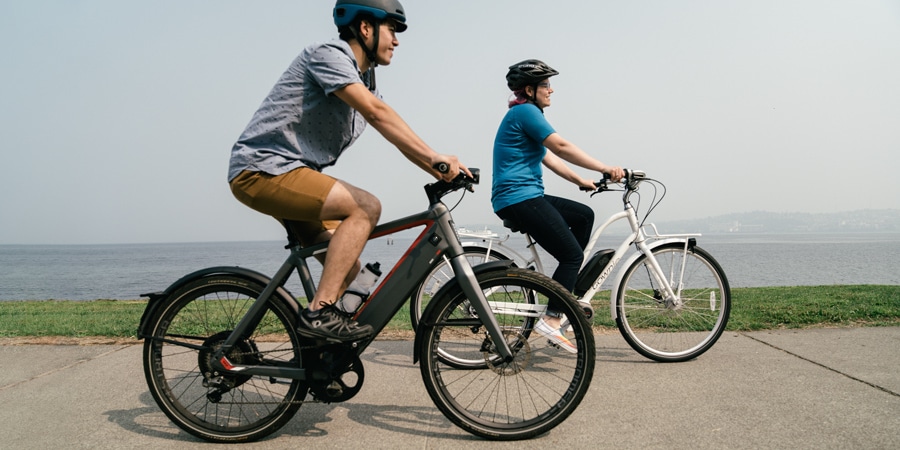How to choose an electric bike

If your curiosity has led to Google searches such as “electric bike toronto”, and would like to know more about the different types of electric bikes available, then you’re in the right place!
Riding an electric bike, also known as an e-bike, is a ticket to a greater sense of freedom and autonomy. There are electric bikes out there for every type of situation: whether it’s commuting to work to beat the traffic, trekking cross-country, taking the kids to and from school, or simply a little joyride around the neighborhood.
There’s an electric alternative to any kind of traditional bike! These include road bikes, mountain bikes, hybrid bikes, cruiser bikes, folding bikes, and even cargo bikes.
Understanding the three classes of electric bikes
There are three different classifications of electric bikes, each based on their level of motor assistance. It is important to know these to determine which electric bike is best for you:
- Class 1: Also known as a “low-speed pedal-assisted ebike”. Class 1 eBikes provide motor assistance only when the user is pedaling, and reach a maximum speed of 32 km/h (20 mph).
- Class 2: Also known as a “low-speed throttle-assisted ebike”. Class 2 eBikes provide motor assistance by pedaling or by a throttle, but reach a maximum speed of 32 km/h (20 mph).
- Class 3: Also known as a “speed pedal-assisted ebike”. Class 3 eBikes provide motor assistance only when the user is pedaling, and can reach a maximum speed of 45 km/h.
New riders often begin with a Class 1 electric bike.
Class 1 eBikes are the most affordable and beginner-friendly on the market.
Riders can ride on city streets as well as bike lanes.
Electric bike users have the right to ride on bike lanes as well as city streets, so you can ride in absolute confidence and efficiency!
Class 2 eBikes are also permitted to ride in the same areas as Class 1 eBikes.
This is due to the fact that both classes of electric bikes reach a maximum speed of 32 km/h (20 mph).
Commuters and couriers prefer Class 3 electric bikes.
Class 3 eBikes can reach higher speeds and are generally equipped with more powerful specs when compared to Class 1 eBikes. The increased performance allows you to weave through traffic faster and more effectively, and you can carry greater loads without getting bogged down.
However, Canada does not permit Class 3 eBikes to be used, as they reach speeds greater than 32 km/h (20 mph). They are also more expensive than Class 1 and 2 electric bikes, and cannot be used on bike paths and trails.
Batteries, Motors, and Ranges
Electric bike manufacturers place utmost importance on the heart of every eBike: the battery and the motor. This electrical system works in unison, and dictates the performance and riding range of the bike.
The battery is the source of power that propels the bike from A to B. Most modern eBike batteries are made from lithium-ion, and can be reliably used for 5-6 years if maintained properly.
The motor takes electrical energy located in the battery and transforms it into mechanical energy that moves the bike. A stronger motor will provide more torque and thus more assistance, but will consume more battery power. This in turn can limit the range your electric bike is capable of.
On the topic of range, this refers to the amount of time you can ride your electric bike in one battery charge. On an eBike, you can generally expect an autonomy of 30 km to 110 km (18 to 70 miles), depending on a number of factors such as power assistance level, total weight load, terrain, hill grades, etc.
Battery charge time:
Most lithium-ion batteries for eBikes take around 3 to 6 hours to fully charge from empty, with larger capacity batteries taking more time.
Number of batteries:
There are a few electric bikes in the market that have dual battery capabilities, and can greatly prolong the duration of your rides. The battery system tracks the charge states of each battery, and switches between the two at every 5% charge decline. This ensures that each battery is used equally and maintains their individual service lives.
It is also totally possible to purchase a separate battery at your local eBike dealer, and to keep with you in case you need to switch your battery mid-trip.
Battery mounting setup:
Batteries integrated in the frame free up space for accessories such as bottle cages or a small bike bag. External batteries, on the other hand, are more convenient to charge and replace.
Making sure your electric bike fits properly
When you’re shopping for a bike, electric or non-electric, it is imperative to ensure that your dream bike actually fits you properly.
The most important part of making sure your bike fits is determining the bike frame’s size with regards to your height. If the frame is too big or too small, no amount of adjustments or customizations will make your bike truly comfortable. There are also other factors that you should take into account when fitting your bike, such as frame geometry, bike standover height, etc.
Visiting your local electric bike dealer is the best way to determine the best size for you. The team will be able to assess your height and size to ensure that your knees, shoulders, back and hands are all placed correctly for the most comfortable cycling experience possible.
All in all…
If you want the best electric bike experience possible, and have found yourself searching “ebike toronto” on Google, be sure to visit the attached link! Their passionate team of eBike experts will attentively tune into your needs to pair you with an electric bike that fits you like a glove.



